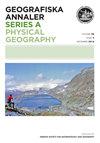Glacier recession in the Altai Mountains of Mongolia in 1990–2016
IF 1.8
4区 地球科学
Q3 GEOGRAPHY, PHYSICAL
Geografiska Annaler Series A-Physical Geography
Pub Date : 2018-04-03
DOI:10.1080/04353676.2017.1407560
引用次数: 24
Abstract
ABSTRACT Relatively little is known about glaciers in the continental climates of North Asia and even less is known about the glaciers of the Mongolian Altai. In an attempt to fill this knowledge gap, we present a new satellite-derived glacier inventory for the Altai Mountains of Mongolia, using the recently launched Landat-8 OLI and Sentinel-2A MSI sensors to monitor glacier change from 1990 to 2016. We examine changes in climatic trends and glacier topomorphological parameters in conjunction with glacier fluctuations to determine governing controls over glacier recession in the Altai Mountains. Our glacier mapping results produced 627 debris-free glaciers with an area of 334.0 ± 42.3 km2 as of 2016. These data were made available for download through the Global Land Ice Measurements from Space (GLIMS) initiative. A subsample of 206 glaciers that were mapped in 1990, 2000, 2010, and 2016 revealed that from 1990 to 2016, glacier area reduced by 43% at 6.4 ± 0.4 km2 yr−1. Glacier recession was greatest from 1990 to 2000 at a rate of 10.9 ± 0.8 km2 yr−1, followed by 2010–2016 at 4.4 ± 0.3 km2 yr−1. Rates of glacier recession were significantly correlated with intrinsic glacier parameters, including mean, minimum and range elevations, mean slope and aspect. Furthermore, climate records indicated the warmest summer temperatures occurred during periods of high glacier recession.1990-2016年蒙古阿尔泰山冰川衰退
对北亚大陆性气候冰川的了解相对较少,对蒙古阿尔泰冰川的了解就更少了。为了填补这一知识空白,我们提出了一种新的基于卫星的蒙古阿尔泰山冰川清单,使用最近发射的Landat-8 OLI和Sentinel-2A MSI传感器监测1990年至2016年的冰川变化。我们研究了气候趋势和冰川地形参数的变化以及冰川波动,以确定对阿尔泰山冰川衰退的控制。截至2016年,我们的冰川测绘结果产生了627个无碎片冰川,面积为334.0±42.3 km2。这些数据可通过全球陆冰空间测量计划(GLIMS)下载。对1990年、2000年、2010年和2016年绘制的206个冰川的子样本进行分析发现,1990年至2016年,冰川面积减少了43%,减少幅度为6.4±0.4 km2 yr−1。1990 - 2000年冰川退缩幅度最大,为10.9±0.8 km2 yr - 1, 2010-2016年次之,为4.4±0.3 km2 yr - 1。冰川退缩速率与冰川内禀参数(包括平均海拔、最小海拔和最高海拔、平均坡度和坡向)显著相关。此外,气候记录表明,最温暖的夏季气温发生在冰川高度消退的时期。
本文章由计算机程序翻译,如有差异,请以英文原文为准。
求助全文
约1分钟内获得全文
求助全文
来源期刊
CiteScore
3.60
自引率
0.00%
发文量
12
审稿时长
>12 weeks
期刊介绍:
Geografiska Annaler: Series A, Physical Geography publishes original research in the field of Physical Geography with special emphasis on cold regions/high latitude, high altitude processes, landforms and environmental change, past, present and future.
The journal primarily promotes dissemination of regular research by publishing research-based articles. The journal also publishes thematic issues where collections of articles around a specific themes are gathered. Such themes are determined by the Editors upon request. Finally the journal wishes to promote knowledge and understanding of topics in Physical Geography, their origin, development and current standing through invited review articles.

 求助内容:
求助内容: 应助结果提醒方式:
应助结果提醒方式:


